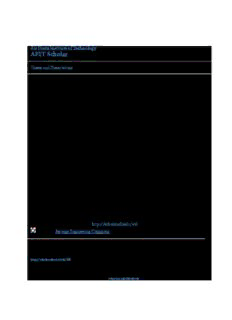Table Of ContentAir Force Institute of Technology
AFIT Scholar
Theses and Dissertations Student Graduate Works
9-15-2016
Application of Executable Architecture in Early
Concept Evaluation using the DoD Architecture
Framework
Zhongwang Chua
Follow this and additional works at:https://scholar.afit.edu/etd
Part of theSystems Engineering Commons
Recommended Citation
Chua, Zhongwang, "Application of Executable Architecture in Early Concept Evaluation using the DoD Architecture Framework"
(2016).Theses and Dissertations. 268.
https://scholar.afit.edu/etd/268
This Thesis is brought to you for free and open access by the Student Graduate Works at AFIT Scholar. It has been accepted for inclusion in Theses and
Dissertations by an authorized administrator of AFIT Scholar. For more information, please [email protected].
APPLICATION OF EXECUTABLE ARCHITECTURE IN EARLY CONCEPT
EVALUATION USING THE DOD ARCHITECTURE FRAMEWORK
THESIS
Zhongwang Chua, Military Expert 5 (Major), Republic of Singapore Air Force
AFIT-ENV-MS-16-S-038
DEPARTMENT OF THE AIR FORCE
AIR UNIVERSITY
AIR FORCE INSTITUTE OF TECHNOLOGY
Wright-Patterson Air Force Base, Ohio
DISTRIBUTION STATEMENT A
APPROVED FOR PUBLIC RELEASE; DISTRIBUTION UNLIMITED
The views expressed in this thesis are those of the author and do not reflect the official
policy or position of the United States Air Force, Department of Defense, the U.S.
Government, the corresponding agencies of any other government, the North Atlantic
Treaty Organization or any other defense organization.
AFIT-ENV-MS-16-S-038
APPLICATION OF EXECUTABLE ARCHITECTURE IN EARLY CONCEPT
EVALUATION USING THE DOD ARCHITECTURE FRAMEWORK
THESIS
Presented to the Faculty
Department of Systems Engineering and Management
Graduate School of Engineering and Management
Air Force Institute of Technology
Air University
Air Education and Training Command
In Partial Fulfillment of the Requirements for the
Degree of Master of Science in Systems Engineering
Zhongwang Chua, BS (Hons)
Military Expert 5 (Major), Republic of Singapore Air Force
September 2016
DISTRIBUTION STATEMENT A
APPROVED FOR PUBLIC RELEASE; DISTRIBUTION UNLIMITED
AFIT-ENV-MS-16-S-038
APPLICATION OF EXECUTABLE ARCHITECTURE IN EARLY CONCEPT
EVALUATION USING THE DOD ARCHITECTURE FRAMEWORK
Zhongwang Chua, BS (Hons)
Military Expert 5 (Major), Republic of Singapore Air Force
Committee Membership:
Dr. David R. Jacques
Chair
Dr. John M. Colombi
Member
Maj Christina Rusnock, Ph. D
Member
Acknowledgments
I would like to express my sincere appreciation to my faculty advisor, Dr David Jacques,
for his guidance and support throughout the course of this thesis effort. The insight and
experience was certainly appreciated. I would also like to recognize the contribution of
my teammates, Capt Andrews Roberts, Lidia Toscano and Capt Nicholas Gilbert, for
their cooperation in the development of related architectural products for SENG 640.
Most importantly, I sincerely thank my family for their support and patience during the
course of my studies.
Zhongwang Chua
iv
Table of Contents
Page
Acknowledgments.............................................................................................................. iv
Table of Contents .................................................................................................................v
List of Figures .................................................................................................................. viii
List of Tables ..................................................................................................................... xi
List of Acronyms ............................................................................................................. xiii
Abstract ..............................................................................................................................xv
I. Introduction .....................................................................................................................1
Overview ......................................................................................................................1
Motivation ....................................................................................................................2
Problem Statement........................................................................................................5
Research Objectives .....................................................................................................6
Research Focus .............................................................................................................7
Methodology Overview ................................................................................................7
Assumptions .................................................................................................................8
Preview .........................................................................................................................9
II. Literature Review ..........................................................................................................10
Overview ....................................................................................................................10
System Architecting as a viable solution....................................................................10
DoDAF as Tool for Early Concept Evaluation in DoD .............................................13
System Architecting—From Static Viewpoints to Dynamic Executable Models ......15
Conclusion ..................................................................................................................32
III. Methodology ................................................................................................................33
v
Chapter Overview .......................................................................................................33
Overview of Research Methodology ..........................................................................34
Implementation of Methodology ................................................................................36
Conclusion ..................................................................................................................70
IV. Analysis and Results ...................................................................................................71
Chapter Overview .......................................................................................................71
Statistical Methods Application .................................................................................71
Analysis of Results: MOE 1—Target Acquisition Percentage ..................................75
Analysis of Results: MOE 2—False Alarm Percentage .............................................82
Analysis of Results: MOE 3—Time-to-Strike ...........................................................89
Analysis of Results: MOE 4—Target Destruction Percentage ..................................97
Objective Hierarchy Process ....................................................................................104
Summary...................................................................................................................105
V. Conclusions and Recommendations ..........................................................................107
Introduction of Research ..........................................................................................107
Research Question 1: Which views of DoDAF are critical for effective construction
of EA? .......................................................................................................................107
Research Question 2: What level of Operational or functional hierarchy of
component sub-systems is required for EA to be effective? ....................................110
Research Question 3: How can EA be used to identify and evaluate the impact of
design parameters on MOEs and MOPs? .................................................................112
Research Question 4: Which are the key parameters that have significant impact to
design and operational cost for the multi-tiered UAV architecture considered herein?114
vi
Effectiveness of Innoslate Software in EA ...............................................................116
Recommendations for Future Research....................................................................117
Summary or Significance of Research .....................................................................118
Appendix ..........................................................................................................................120
Bibliography ....................................................................................................................149
vii
List of Figures
Page
Figure 1: Commitment, system-specific knowledge, cost incurred and east of Change
(Blanchard & Fabrycky, 1998). ................................................................................... 3
Figure 2: Functional Reasons for Cost Over-run (Berteau et al., 2011) ............................. 5
Figure 3: Semantic Areas of UML (OMG UML, pg 14, 2015) ........................................ 21
Figure 4: Relationship between SysML and UML (OMG, 2015) .................................... 23
Figure 5: Relations between Static and Dynamic Models ................................................ 28
Figure 6: Example of Dynamic Results over time ............................................................ 30
Figure 7: Example of Pareto Frontier for different variation within each CA .................. 30
Figure 8: Classification of Different UAS tiers ................................................................ 38
Figure 9: Use Case Diagram ............................................................................................. 40
Figure 10: OV-1 of Multi-tiered UAS SoS ....................................................................... 48
Figure 11: OV-2 High level Resource Flow Diagram of Multi-tiered UAS SoS ............. 49
Figure 12: OV-5a Operational Activities Decomposition Tree ........................................ 50
Figure 13: OV-5B Activity Flow Diagram of the Multi-tiered UAS SoS ........................ 51
Figure 14: DIV 2 of Multi-tier UAS SoS.......................................................................... 54
Figure 15: Overview of Simulation .................................................................................. 57
Figure 16: Modified 0V-5B for Simulation ...................................................................... 58
Figure 17: Summary of Target Acquisition Percentage ................................................... 75
Figure 18: Summary of Target Acquisition MOE with 95% CI ....................................... 76
Figure 19: Main Effect Plot for Target Acquisition Percentage MOE ............................. 78
viii
Description:Defense (DoD) projects and proposes a methodology using Executable . Preview. While this research thesis focuses on the application of EA in .. UML enables architects to develop models in three major categories of model.

